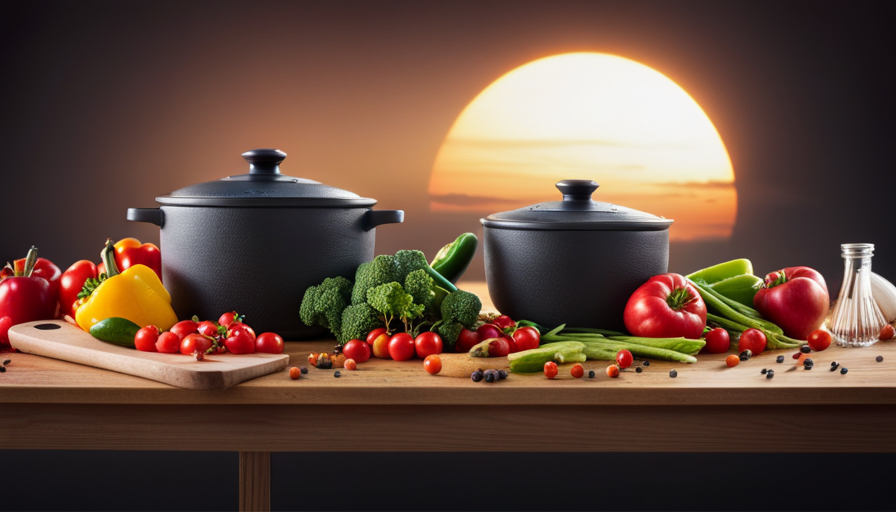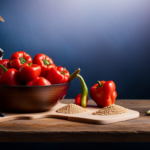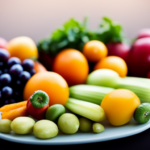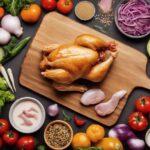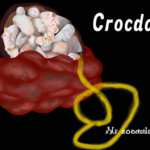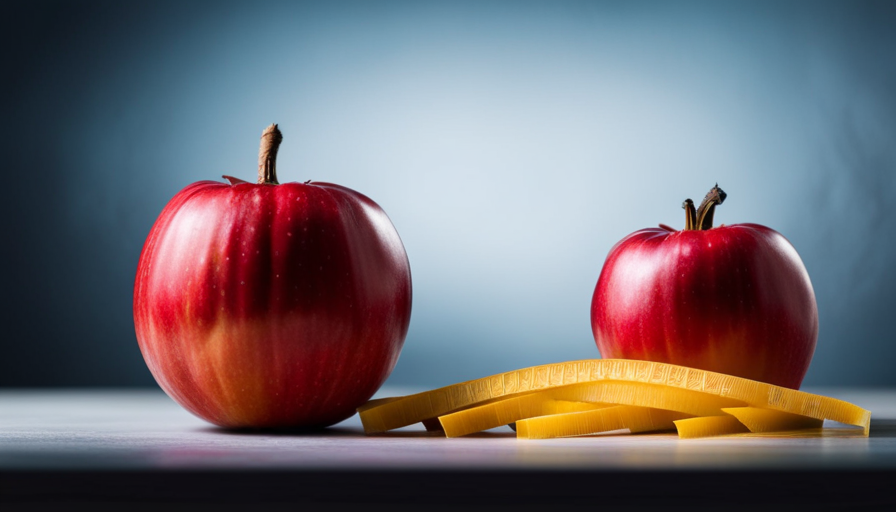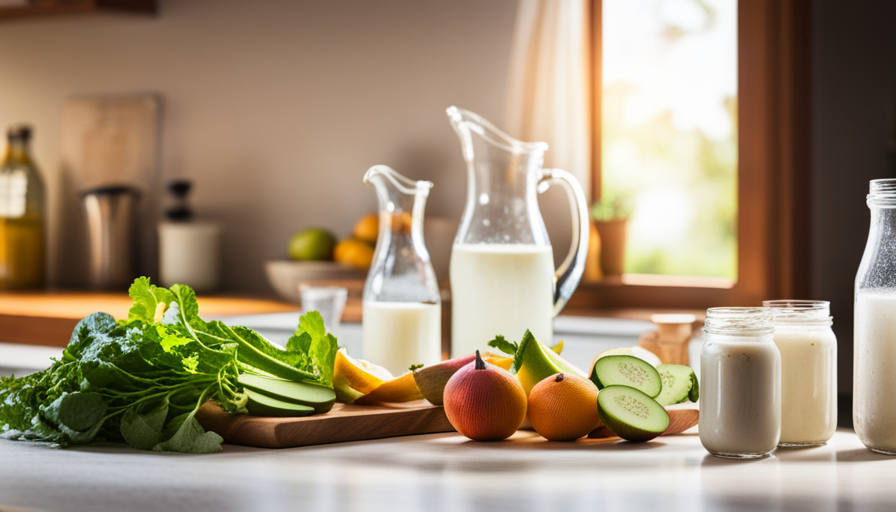It’s quite a coincidence that you came across this piece just as you were searching for information on the best diet for dogs fighting cancer. You’ve found the right place! Nutrition plays a crucial role in helping our beloved furry friends battle cancer and can greatly affect their overall health and recovery.
But the question remains: is raw food, cooked food, or a combination of both better for canines battling cancer?
In this article, we will delve into the world of canine nutrition and explore the benefits of raw and cooked food for canines with cancer. We will also discuss the importance of evaluating the nutritional needs of canine cancer patients, considering digestive health and food safety, and assessing the impact of heat on nutrient loss.
So, grab a cup of tea, sit back, and let’s uncover the optimal diet to support our canine companions in their fight against cancer.
Key Takeaways
- Canine nutrition plays a crucial role in the well-being and recovery of dogs fighting cancer.
- The benefits and risks of raw food, cooked food, and a combination of both should be explored for canines with cancer.
- Canine gut health is important in fighting cancer and strengthening the immune system.
- Foods rich in antioxidants, such as blueberries, broccoli, and spinach, can support cancer treatment in dogs.
Understanding Canine Nutrition and Cancer
Are you curious about how your dog’s diet can affect their cancer treatment? Understanding canine nutrition and its correlation with cancer is crucial in ensuring the overall well-being of your furry companion.
When it comes to fighting cancer in canines, paying attention to their diet is of utmost importance. One key aspect to consider is canine gut health. The health of your dog’s gut plays a significant role in their overall health, including their ability to fight cancer. A diet that supports a healthy gut can help strengthen their immune system and improve their chances of combating cancer.
Additionally, incorporating foods rich in antioxidants can have a positive impact on your dog’s cancer treatment. Antioxidants are compounds that help protect the body from harmful free radicals, which can contribute to the development and progression of cancer. By including foods such as blueberries, broccoli, and spinach in your dog’s diet, you’re providing them with a good source of antioxidants. These antioxidants can help reduce inflammation, support the immune system, and potentially slow down the growth of cancer cells.
When it comes to fighting cancer in canines, paying attention to their diet is essential. Focus on maintaining a healthy gut and incorporating foods rich in antioxidants. By doing so, you can provide your dog with the best chance at fighting cancer and improving their overall well-being.
The Benefits of Raw Food for Canines with Cancer
Indulging in a succulent feast of nature’s bounty, your furry companion’s health blossoms like a vibrant garden in the springtime. When it comes to canines fighting cancer, raw food diets offer a myriad of benefits.
Research suggests that raw food diets can provide essential nutrients that support the immune system and promote overall well-being in dogs with cancer.
However, it’s important to be aware of the potential risks associated with raw food diets for canines with cancer. Raw food may contain harmful bacteria such as Salmonella or E. coli, which can pose a threat to the weakened immune system of a dog battling cancer. To mitigate these risks, it’s crucial to handle and prepare raw food with utmost care, ensuring proper hygiene and maintaining a clean feeding area.
Incorporating supplements into raw food diets is another strategy to enhance the nutritional support for canines with cancer. Supplements like omega-3 fatty acids, antioxidants, and probiotics can play a vital role in boosting the immune system and reducing inflammation. Consulting with a veterinary oncologist or a veterinary nutritionist can help determine the appropriate supplements and their dosages for your canine companion.
A raw food diet can be beneficial for canines with cancer, but it’s essential to be aware of the potential risks and take necessary precautions. With proper handling and the inclusion of supplements, raw food can provide the necessary nutrients to support your furry friend’s fight against cancer.
The Benefits of Cooked Food for Canines with Cancer
When prepared properly, cooked meals can provide a nourishing alternative for dogs battling cancer, offering a variety of health benefits. Cooking methods for canine cancer diets play a crucial role in maximizing nutrition and minimizing potential risks.
One of the main advantages of cooked food is that it can be easier for dogs with cancer to digest, especially if they have compromised immune systems or gastrointestinal issues. Cooking can break down the food, making it more accessible for absorption and reducing the risk of bacterial contamination.
Home cooked meals for dogs with cancer also allow for customization based on their specific dietary needs. You have the ability to carefully select ingredients that are rich in antioxidants, vitamins, and minerals, which can help support their immune system and overall health. Additionally, cooking can help improve the palatability of the food, making it more enticing for dogs who may have a decreased appetite due to cancer or its treatments.
It’s important to note that cooking methods should be gentle to preserve the nutritional value of the ingredients. Steaming, boiling, or lightly sautéing food can help retain important nutrients while ensuring the food is safe for consumption. Avoid overcooking or using high temperatures, as this can cause nutrient loss.
Overall, cooking can offer a nourishing and tailored approach to canine cancer diets. It allows you to provide a variety of nutrients while addressing specific dietary needs, giving your furry friend the best chance at fighting cancer.
Evaluating Nutritional Needs for Canine Cancer Patients
To ensure your furry friend has the best chance at fighting cancer, it’s crucial to evaluate their nutritional needs, just like a doctor would assess a patient’s diet.
When it comes to canine cancer patients, evaluating their dietary requirements becomes even more important. Cancer can take a toll on a dog’s body, weakening their immune system and causing weight loss. Therefore, providing them with the right nutrients is essential for their overall well-being and to support their fight against the disease.
One way to evaluate the nutritional needs of canine cancer patients is by considering dietary supplements. These supplements can help fill any nutritional gaps that may exist in their regular diet. They often contain essential vitamins, minerals, and antioxidants that can support the immune system and aid in the body’s natural defenses against cancer cells.
Speaking of antioxidants, they play a crucial role in cancer treatment. These powerful substances can help neutralize harmful free radicals in the body, which can cause damage to cells and contribute to the development and progression of cancer. Including foods rich in antioxidants, such as blueberries, spinach, and broccoli, can be beneficial for canine cancer patients.
Evaluating the nutritional needs of canine cancer patients is essential for their overall health and well-being. Incorporating dietary supplements and including antioxidant-rich foods can provide vital support in their fight against cancer. By taking these steps, you can help give your furry friend the best chance at a successful battle against this devastating disease.
Considering Digestive Health and Food Safety
Considering the importance of digestive health and ensuring food safety is crucial for supporting the overall well-being of canine cancer patients. When it comes to feeding dogs with cancer, it’s essential to pay close attention to their digestive health and take necessary precautions to prevent any potential risks.
Here are a few key points to explore regarding digestive health and food safety for canines fighting cancer:
-
Potential Risks:
- Raw Food: While some proponents argue that raw food diets are beneficial for dogs, there’s an increased risk of bacterial contamination such as Salmonella or E. coli. This can be especially dangerous for dogs with weakened immune systems due to cancer treatments.
- Cooked Food: Cooking food can eliminate potential pathogens, but it may also reduce the nutritional value of certain ingredients. It’s important to strike a balance between cooking and preserving nutrients.
-
Addressing Common Concerns:
- Consult with a Veterinary Nutritionist: They can provide tailored dietary recommendations that address the specific needs of your canine cancer patient.
- Choose High-Quality Ingredients: Opt for well-balanced, commercially prepared diets that meet the nutritional requirements of dogs with cancer.
- Practice Safe Food Handling: This includes washing hands thoroughly after handling food, cleaning food bowls regularly, and storing food properly to prevent contamination.
By considering the digestive health and food safety of canine cancer patients, you can help provide them with the best possible nutrition while minimizing potential risks. Always consult with a veterinarian to ensure you’re making informed decisions for your furry friend’s well-being.
Exploring the Role of Enzymes in Cancer Treatment
Enzymes play a crucial role in supporting the treatment of cancer in your furry friend, aiding in the breakdown and absorption of nutrients to support their overall well-being. Enzyme therapy has gained recognition as a complementary approach to cancer treatment in canines. These specialized proteins help in breaking down complex molecules into smaller, more easily absorbable forms, ensuring that your dog receives the necessary nutrients to fight the disease.
The role of enzymes in cancer treatment is not limited to aiding digestion. They can also help modulate the immune response, reduce inflammation, and support the body’s detoxification processes. By enhancing the body’s natural defense mechanisms, enzymes can potentially improve the efficacy of other cancer treatments, such as chemotherapy or radiation therapy.
To give you a clearer understanding of the importance of enzymes in cancer treatment, let’s take a look at this emotional evoking table:
| Enzyme Therapy Benefits | Emotional Impact |
|---|---|
| Improved nutrient absorption | Provides hope for better nourishment |
| Modulation of immune response | Offers a fighting chance |
| Reduction of inflammation | Eases discomfort and pain |
| Support for detoxification processes | Promotes overall well-being |
It is important to note that enzyme therapy should be used under the guidance of a veterinarian experienced in cancer treatment. They will be able to recommend the appropriate enzymes and dosage based on your dog’s specific condition. With the right approach, enzymes can be a valuable addition to the treatment plan for your beloved canine companion.
Assessing the Impact of Heat on Nutrient Loss
The scorching heat of the sun mercilessly robs essential nutrients from the nourishing sustenance. When it comes to fighting cancer in canines, nutrient preservation is vital. The impact of heat on nutrient loss is a crucial factor to consider when assessing the benefits of raw food versus cooked food.
Cooking methods play a significant role in determining the amount of nutrients retained in the food. The cooking process can cause chemical changes in food, leading to the degradation of vitamins, minerals, and enzymes. High temperatures can destroy heat-sensitive nutrients, such as vitamin C and B vitamins. However, cooking can also increase the bioavailability of certain nutrients, making them easier for the body to absorb.
Different cooking methods have varying effects on nutrient preservation. Boiling and steaming are known to cause the most significant nutrient loss, while methods like baking and roasting are more effective at retaining nutrients. It is important to note that overcooking can also lead to nutrient depletion.
To maximize nutrient preservation, it is recommended to use gentle cooking methods like lightly steaming or baking at lower temperatures. Additionally, incorporating a combination of raw and cooked foods in a canine’s diet can provide a balance of nutrients and enzymes. This approach ensures that the cancer-fighting properties of both raw and cooked foods are utilized effectively.
Balancing Protein, Fat, and Carbohydrates in Canine Cancer Diets
To achieve a well-balanced canine cancer diet, you should strive to maintain a proper ratio of protein, fat, and carbohydrates. Balancing macronutrients is crucial in supporting your dog’s overall health and fighting cancer.
Protein is especially important as it helps repair and build tissues, strengthens the immune system, and aids in the production of enzymes and hormones. Good sources of protein for canine cancer diets include lean meats, fish, eggs, and dairy products.
In addition to protein, the right amount and type of fats are essential for your dog’s well-being. Fats provide energy, help absorb certain vitamins, and support a healthy coat and skin. Opt for healthy fats like omega-3 fatty acids found in fish, flaxseed, and chia seeds.
Carbohydrates, on the other hand, should be chosen wisely. Stick to complex carbohydrates such as whole grains, fruits, and vegetables, which provide a steady source of energy and fiber.
When determining the optimal calorie intake for your dog, it’s important to consider factors such as their weight, size, activity level, and stage of cancer. Consult with a veterinarian or a veterinary nutritionist to calculate the appropriate calorie intake for your furry friend. They can also help you determine the ideal balance of macronutrients based on your dog’s specific needs.
Remember, a well-balanced canine cancer diet is a crucial part of supporting your dog’s overall health and well-being during their cancer fight. So, take the time to assess and adjust their food accordingly, ensuring they receive the necessary nutrients to aid in their battle against cancer.
Tailoring the Diet to Individual Canine Cancer Cases
When tailoring your dog’s diet to their individual cancer case, you can work with a veterinarian to determine the best balance of nutrients for their specific needs. This has been shown to significantly improve their overall well-being and treatment outcomes. Canine cancer nutrition is a crucial aspect of their care, as it plays a vital role in supporting their immune system and fighting against the disease.
By creating personalized dietary plans, you can ensure that your dog is receiving the right combination of nutrients to strengthen their body and enhance their response to treatment.
To evoke emotion in the audience, consider the following sub-lists:
-
Increased Energy: Providing your dog with a diet tailored to their cancer case can help boost their energy levels, allowing them to maintain their vitality and zest for life during treatment.
-
Enhanced Appetite: Cancer treatment can often lead to a decrease in appetite, but a personalized dietary plan can help stimulate their taste buds and encourage them to eat, ensuring they receive the necessary nutrition.
-
Improved Quality of Life: A well-balanced diet can enhance your dog’s overall well-being, helping them feel more comfortable during their treatment journey and improving their overall quality of life.
By focusing on personalized dietary plans, you can give your furry friend the best fighting chance against cancer while also improving their overall health and well-being. Remember to consult with a veterinarian to ensure you’re providing the right balance of nutrients for your dog’s specific needs.
Consulting with a Veterinarian for Nutritional Guidance
Consulting with a veterinarian is crucial for obtaining expert guidance on the appropriate nutritional plan for your dog’s individual cancer case. Veterinary expertise is essential in understanding the specific needs of your canine companion and tailoring their diet to optimize their health during cancer treatment.
A veterinarian can provide personalized recommendations based on factors such as the type and stage of cancer, the dog’s overall health, and any concurrent treatments. They can assess your dog’s nutritional status and advise on the best approach to meet their dietary requirements.
They can recommend specific foods or supplements that may help support the immune system, promote weight management, and reduce inflammation. Additionally, they can guide you on the appropriate balance between raw and cooked foods, considering your dog’s specific condition.
Furthermore, a veterinarian can monitor your dog’s response to the nutritional plan and make necessary adjustments as needed. They can provide ongoing support and guidance throughout the treatment process, ensuring that your dog receives the best possible care.
Remember, each canine cancer case is unique, and what works for one dog may not be suitable for another. Consulting with a veterinarian who specializes in oncology or nutrition will help ensure that your dog’s dietary needs are met with expert guidance and personalized recommendations.
Frequently Asked Questions
How does understanding canine nutrition help in fighting cancer in canines?
Understanding canine nutrition is crucial when it comes to fighting cancer in canines. By having a deep understanding of their nutritional needs, you can provide them with the right diet to support their immune system and overall health.
Proper nutrition can help combat the effects of cancer and improve their quality of life. By incorporating a balanced diet, you can ensure that your furry friend is getting the necessary nutrients to fight off cancer and stay strong.
Are there any benefits of feeding raw food to canines with cancer?
Feeding raw food to canines with cancer has some potential benefits, but it also comes with its share of pros and cons.
On the positive side, raw food diets typically contain high-quality ingredients that can support the immune system and overall health.
However, transitioning to a raw food diet may be challenging for some dogs, especially those with compromised digestive systems.
It’s important to consult with a veterinarian and consider all factors before making any dietary changes for a canine with cancer.
What are the benefits of feeding cooked food to canines with cancer?
Feeding cooked food to canines with cancer offers a range of nutritional benefits that can aid in their fight against the disease. Cooked food is easier to digest, ensuring that essential nutrients are readily absorbed by their bodies. This increased digestibility allows canines to maintain a healthy weight and support their immune system.
Additionally, cooked food can be customized to meet specific dietary requirements, providing canines with the necessary nutrients to combat cancer.
How do you evaluate the nutritional needs of canine cancer patients?
To evaluate the nutritional needs of canine cancer patients, you need to consider various factors. Start by assessing the dog’s overall health, stage of cancer, and any existing dietary restrictions.
Consult with a veterinarian or veterinary nutritionist to create a tailored diet plan. Focus on providing a balanced diet that includes high-quality proteins, healthy fats, and appropriate amounts of carbohydrates.
Consider dietary supplements and antioxidants to support the dog’s immune system. Keep in mind that individual dogs may have unique dietary considerations, so it’s crucial to monitor their response and adjust the diet accordingly.
Is digestive health and food safety important when considering a diet for canines with cancer?
When considering a diet for canines with cancer, digestive health and food safety are crucial factors to keep in mind.
Ensuring that your dog’s digestive system is functioning optimally is essential for their overall well-being. Additionally, prioritizing food safety will help reduce the risk of any potential complications or adverse reactions.
By focusing on these aspects, you can provide your furry friend with a diet that supports their health and aids in their fight against cancer.
Remember, as the saying goes, "You’re what you eat."
Does Switching to Raw Food Cause Lethargy in Canines Fighting Cancer?
Switching pets to a raw food transition during cancer treatment may cause lethargy initially. However, this adjustment period is normal as their bodies adapt to the new diet. Consult your vet for guidance on easing the transition to ensure your canine’s energy levels are supported during this critical time.
Conclusion
In conclusion, when it comes to fighting cancer in canines, there’s no one-size-fits-all answer. Both raw and cooked food can provide benefits for dogs with cancer, depending on their individual needs and preferences.
It’s crucial to evaluate nutritional needs, consider digestive health and food safety, and assess the impact of heat on nutrient loss. Interestingly, a study conducted by the Journal of Veterinary Internal Medicine found that a raw food diet can lead to a higher remission rate in dogs with lymphoma.
However, it’s essential to consult with a veterinarian for personalized nutritional guidance to ensure the best possible outcome for your furry friend.

